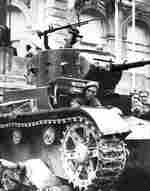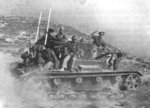T-26
| Country | Russia |
| Manufacturer | Factory No. 174, Leningrad, Russia |
| Primary Role | Light Tank |
Contributor: C. Peter Chen
ww2dbaseThe T-26 light tanks were developed by the OKMO of Bolshevik Factory in Leningrad, Russia based on the British firm Vickers-Armstrongs' Mk. E 6-ton light tank design, purchased by the Soviet Union in 1930. Production began on 26 Jan 1931, and the first examples entered service on 13 Feb. As time went on in the 1930s, the T-26 design slowly grew apart from the original British design. In 1931, the machine gun turrets' firing ports were converted from their original circular shape to a rectangular shape in order to better accommodate Degtyarev machine guns. In Mar 1932, air intake systems were upgraded to deal with snow. In 1933, the T-26 Model 1933 variant design was unveiled, which upgraded the design's primary weapon from two machine guns to a single 37-millimeter cannon or, more commonly, a single 45-millimeter cannon. Through the 1930s, T-26 tanks received armor upgrades.
ww2dbaseOn 15 Oct 1936, 50 T-26 Model 1933 light tanks arrived in Spain to aid the Republic forces in the Spanish Civil War; this was the first of many shipments of T-26 tanks that eventually total 281 vehicles. In response, Germany delivered tanks to the Spanish Nationalists weeks later. T-26 tanks first saw combat in Spain on 29 Oct 1936. These tanks were found to be far superior to German and Italian light tanks used by the Nationalists, but they were still vulnerable to infantry and towed anti-tank guns. Experiences acquired by the Soviets during the Spanish Civil War contributed greatly to the improvement of Soviet tank warfare doctrine in the late 1930s.
ww2dbaseIn Nov 1937, Chinese delegate to the Soviet Union Ji Yang negotiated a deal in which the Soviets would sell 88 T-26 Model 1933 light tanks and 20 BT-5 or BA combat vehicles to China, plus a generous credit line for various supplies. The vehicles arrived in Guangzhou, Guangdong Province, China in spring 1938, and were assigned shortly after to the Nationalist Chinese 200th Infantry Division. These Chinese T-26 light tanks would later participate in the Battle of Lanfeng in 1938, the Battle of Kunlun Pass in 1939, and the Battle of Yunnan-Burma Road in the Burma campaign in 1942.
ww2dbaseIn 1938, the T-26 Model 1937 was introduced with thicker frontal armor. In 1939, the T-26S variant design was introduced, replacing riveted armor with welded armor to provide better armor protection.
ww2dbaseT-26 light tanks played important roles during the Battle of Khalkhin Gol in 1939, where General Georgi Zhukov effectively deployed T-26 light tanks and infantry in cooperation and defeated the Japanese.
ww2dbaseIn Sep 1939, Soviet Union and Germany jointly invaded Poland during the opening chapter of the European War. At this time, the Soviet Army had about 8,500 T-26 light tanks in service, which represented the majority of the entire Soviet Army armored force; 878 T-26 tanks crossed into Poland from Byelorussia and 797 crossed from Ukraine. Only 15 tanks were lost during the Polish campaign, but 302 were put out of commission due to mechanical failures.
ww2dbaseDuring the Winter War with Finland in 1939-1940, the Soviet Army fielded over 6,000 tanks, a large number of which were T-26 light tanks. They performed poorly against Finnish Army infantry; this was largely attributed to poor tank-infantry coordination. Many tanks, including T-26 tanks, were captured by Finnish forces and pressed into service.
ww2dbaseIn Jun 1941, when Germany invaded the Soviet Union, the Soviet Army had 10,268 T-26 light tanks. By this time, the T-26 design was becoming obsolete in the face of more modern German Panzer III and Panzer IV tanks. By the end of 1941, a great number of T-26 tanks were captured or destroyed. The captured examples were put back into German service in the roles of artillery tractors, self-propelled guns, and infantry support; very few of the captured T-26 tanks were used as front line battle tanks.
ww2dbase1,272 T-26 light tanks participated in Operation August Storm at the end of the war in Asia, which saw Soviet forces attacking Japanese positions in the Manchurian region of Northeast China.
ww2dbaseProduction of T-26 light tanks ceased in 1941. By that time, 10,300 tanks were built.
ww2dbaseAfter WW2, the Nationalist Chinese T-26 light tanks saw action in the Chinese Civil War; many of them were destroyed, but a few were captured by the Communists in 1949. In Finland, T-26 light tanks captured by Finnish forces during the Winter War and Continuation War remained in service until 1961. The Spanish inventory of over 100 captured Republican T-26 light tanks were in service until 1954. Turkey purchased 63 T-26 light tanks from the Soviet Union in 1935, but had already retired them from service in 1942.
ww2dbaseSource: Wikipedia.
Last Major Revision: Sep 2009
T-26 Timeline
| 26 Jan 1931 | Production of T-26 light tanks began in Bolshevik Factory in Leningrad, Russia. |
| 13 Feb 1931 | The first T-26 light tanks entered Soviet military service. |
| 15 Oct 1936 | 50 Soviet T-26 Model 1933 light tanks arrived in Spain to aid the Republic forces in the Spanish Civil War. |
| 29 Oct 1936 | T-26 tanks saw their first combat action in Spain. |
SPECIFICATIONS
T-26 Model 1933
| Machinery | One 6,600cc 4-cylinder air-cooled T-26 engine rated at 90hp |
| Suspension | Leaf quarter-elliptic springs |
| Armament | 1x45mm 20K mod. 1932/34 tank gun (122 rounds), 1x7.62mm DT machine gun |
| Armor | 6mm bottom, 6-10mm top, 15mm hull, 15mm turret |
| Crew | 3 |
| Length | 4.65 m |
| Width | 2.44 m |
| Height | 2.24 m |
| Weight | 9.6 t |
| Speed | 16 km/h off-road; 31 km/h on-road |
| Range | 130 km off-road; 240 km on-road |
Photographs
 |  |  |  |
Please consider supporting us on Patreon. Even $1 per month will go a long way! Thank you. Please help us spread the word: Stay updated with WW2DB: |
Visitor Submitted Comments
17 Nov 2010 12:16:08 PM
The T-26A Model 1931 Light Tank had two
turrets and was limited for up-gunning the
the design.
T-26 Model 1933 carried a much larger turret
armed with a 1x45mm gun, and 1x7.62mm machine
gun. Carried a three man crew. Was powered
by a GAZ 8 cylinder gas engine of 91hp with
a range of 200km/124miles.
28 May 2014 09:13:24 AM
During the Spanish Civil War the 65 T26Bs proved so succesful when pitted against the Nationalist's Panzer Is and CV33s, being invulnerable to their machine-guns, that the Condor Legion offered rewards for the capture of T26 tanks for their own use.
27 Oct 2015 02:20:54 PM
BT: BYSTROKHODNY
Another Soviet tank not described here, is the BT
Series of Fast Tanks. BT tank production started in 1935 this vehicle used engineering design and plans based on the American engineer Walter Christie. One of its more advanced features for the tank, the crew could remove the tracks and drive at speed on its road wheels on paved roads
INDUSTRIAL ESPIONAGE:
In 1930 Soviet agents in New York were able to get the plans along with two (2) Christie M1931 tank chassis without turrets and ship them back to the USSR. Shipping documents described them as agricultural tractors, arrived in the USSR and were shipped to the KhPZ Factory in Kharkov production started in 1932.
Armament was 1 x 45mm main gun w/146 rds. of ammo. Secondary armament was 2 x 7.62mm DT machine guns w/2,394 rounds, not counting the crews personal weapons.
POWER TO THE PEOPLE:
The BT was powered by model M-5, 400hp engine
w/speed of 44mph/72Km/h. During the German invasion of the USSR in June 1941 the Red Army suffered heavy losses in the field against German armor many were lost due to enemy action or mechanical brake downs. By 1942 many BT's were withdrawn from front-line service...
6 Mar 2024 07:46:39 AM
In paragraph 2, last sentence, it says warfore not warfare.
Sorry if this sounds rude, but it bothers me a little bit lol
7 Mar 2024 07:42:06 AM
Thank you, Anonymous of 6 Mar 2024, the typographical error has been corrected.
All visitor submitted comments are opinions of those making the submissions and do not reflect views of WW2DB.

- » US State Lawmaker John Winter Caught Using Racial Slur "Jap" and Apologized (11 Jun 2025)
- » Köln/Cologne Evacuated After Discovery of WW2 Bombs (4 Jun 2025)
- » US Women's Army Corps "Six Triple Eight" Awarded with Congressional Gold Medal (30 Apr 2025)
- » Race, Holocaust, and African-American WW2 Histories Removed from the US Naval Academy Library (7 Apr 2025)
- » US Government Plans to Purge WW2 Information (17 Mar 2025)
- » See all news
- » 1,175 biographies
- » 337 events
- » 44,927 timeline entries
- » 1,245 ships
- » 350 aircraft models
- » 207 vehicle models
- » 376 weapon models
- » 123 historical documents
- » 261 facilities
- » 470 book reviews
- » 28,474 photos
- » 365 maps
Thomas Dodd, late 1945
Please consider supporting us on Patreon. Even $1 a month will go a long way. Thank you!
Or, please support us by purchasing some WW2DB merchandise at TeeSpring, Thank you!
8 Aug 2010 09:32:01 AM
The T-26 Light Infantry Tank, was developed
in the 1930's, from the British Vickers Design.
More than 11,000 were built, and was exported
to many countries. At the start of the German
invasion, June 22,1941 the T-26 suffered heavy losses against German armor.
The tank was phased out of front-line service and replace by newer designs. However, some T-26 tanks were still in service with Soviet forces in Manchuria in
1945.
The survivors were passed on to the Communist Chinese.
Few T-26 Tanks survive today, but a few are
in Museums in Russia, Finland and Spain.